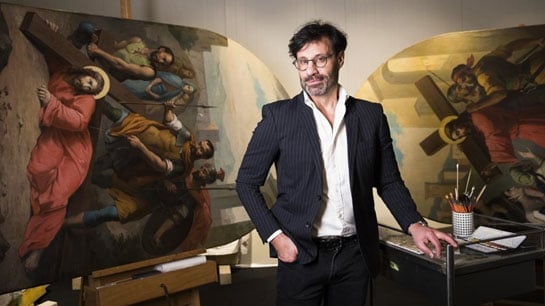Ferverino for Good Friday Stations of the Cross
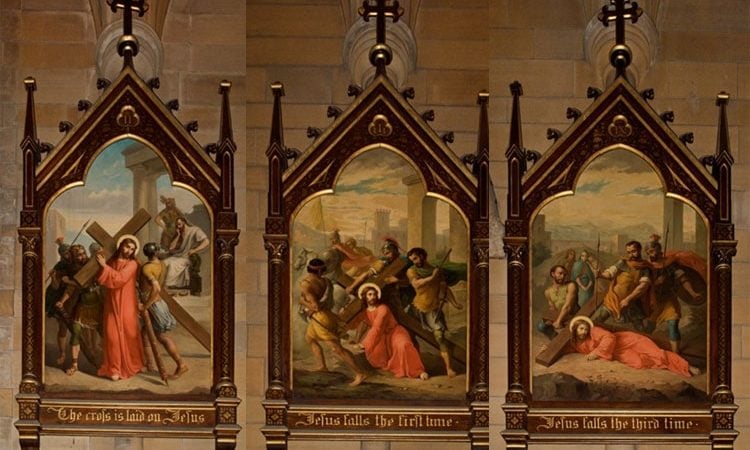
Ferverino for GOOD FRIDAY STATIONS OF THE CROSS
Livestreamed from St. Mary’s Cathedral, Sydney
Isolated yet loving
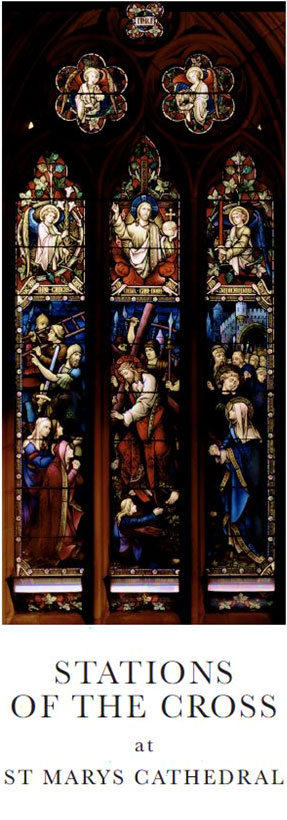
The recently restored paintings of the Stations of the Cross here at St Mary’s Cathedral in Sydney are massive French oils, each weighing 200kg, bought in 1885 by Cardinal Moran from the Chovet studio in Paris. In most, Jesus looks at us, to engage, scrutinise or console. But in some He stares into the middle distance, disconnected from those who are near Him but not truly with Him.
There’s lots of talk of ‘social distancing’ at present, which hopefully means physical distancing and not distancing ourselves socially or spiritually. After all, as social beings, we cannot thrive in isolation. Yet the Way we’ve just walked with Christ was a very lonely one.
The Way of the Cross is preceded by the scene in the Garden, where Jesus’ disciples are oblivious to His agony and desert Him when He’s arrested. Peter, for all the hairy-chested promises of loyalty, turns to jelly when challenged by a servant-girl. Jesus is left to be tried in our first station with no advocate, no witness. How forlorn He must have felt when the Judge gave sentence (1st station). All alone, He took up the burden of the cross and, with it, the weight of humanity’s sin and brokenness, a weight so grave He stumbled thrice. (2nd, 3rd, 7th & 9th).
Even when He encountered others along the Way – Mary, Simon Cyrene, Veronica, the women, soldiers and fellow criminals (2nd, 4th-6th, 8th, 10th-12th) – it was like a man cast adrift and dying of thirst, with “water, water everywhere but not a drop to drink”. People were there, for sure, whole crowds of them, yet He felt so very alone.
As He hung dying, Jesus revealed how bereft He felt by singing a Psalm of Lament, ‘My God, my God, why have you abandoned me?’ It ends with a profession of faith and hope, but demonstrates Jesus knew the abandonment many feel as well. Lepers or others with infectious diseases were treated in the ancient world as moral pariahs and spiritual excommunicates. None would even look them in the eye. So Psalm 22 continues, ‘A worm am I, and no man; a reproach to men and despised by the people. All who see me deride me; they curl their lips and shield their faces.’ Abandoned by His friends and even, so He felt, by His Father-God, Jesus dies alone, is taken down from the cross and laid in that loneliest place, the tomb (12th-14th).
In the present pandemic, even more than normal, some know distancing, isolation and loneliness, so does God on the Way of the Cross. If we feel burdened by present restrictions on worship, work or leisure, we know these burdens are much lighter than those borne by many in our world every day and by the Crucified One on Good Friday. As we offer material, emotional and spiritual support to others at this time, we lighten their load. We become for them the nascent Church as it was for Jesus: a solicitous mother Mary, a face-wiping nurse Veronica, a burden-bearing stranger Simon, bedside companions to the sick and dying, like Mary and John, the holy women and the centurion.
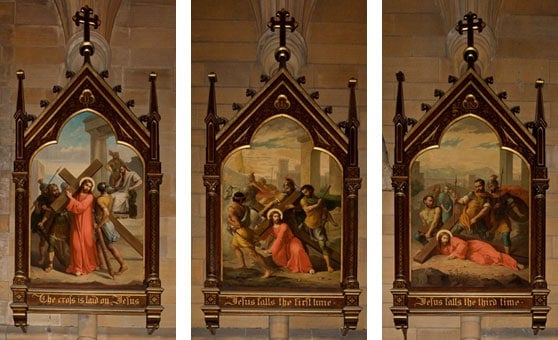
Innocent yet self-sacrificed
In the painted stations here at St Mary’s Cathedral the Lord is robed in the red of kings, blood, the Passion. It’s not the scarlet of sin (Isa 1:18), and when He is stripped we find He wears snow-white beneath. “The sinless one was made sin for us”, made a scapegoat, a sin-offering, though no sinner Himself. Caiaphas, the High Priest, says pragmatically that he’d willingly sacrifice an innocent man for the sake of the people: unwittingly he’s right both as to Jesus’ innocence and His salvific sacrifice. The crowd outside bay for Jesus’ blood. Though Jesus is “the Truth, the whole Truth, and nothing but the Truth”, the judge stares at Him and asks cynically, “Truth – what’s that?” Though Jesus is innocence itself, no threat, no case against Him, as Pilate acknowledges, still this judge washes his hands of Him as if to say “Justice – what’s that?” and He sends Him to His fate.
Here is a society and legal system with little care for questions of innocence or guilt, punishment or dessert, or for principles of presumed innocence or proof beyond reasonable doubt. It’s a culture of indignation and shaming, and so Jesus is displayed at trial as if on TV for the audience’s titillation, vilified in the media of crowd whispers, dragged through the streets for public mockery, stripped of robes and titles, freedom and dignity (1st-10th).
Sad to say, innocent people can still be convicted and punished today, both in the ‘justice’ system and the court of public opinion. Before we point fingers at God for allowing bad things to happen to good people, we might ask whether we are just in all our dealings and what injustices our community tolerates or perpetrates. If we hoard when others have greater need, or seek to make ourselves the exception to every restriction, or simply go with the crowd vilifying an innocent man, or push people of doubtful health or immigration status out to sea, we have become the mad mob and the unjust judge. But when we see the sick and dying, the isolated or anxious from COVID19 and respond with generosity as our health professionals do, and our pastors and our civic officials, we are Veronica wiping the Lord’s fevered brow, Simon of Cyrene helping carry His cross, Mary and John keeping vigil by that Cross, Christ sacrificing Himself.
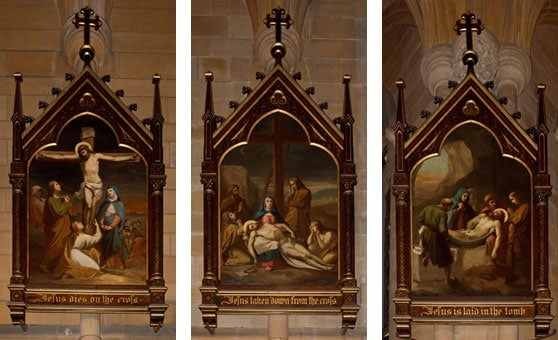
Mistreated but forgiving
Unjustly condemned, Jesus did not consign Caiaphas and Pilate to hell as well He might; “harshly dealt with, he never opened his mouth”. Meeting the wailing women of Jerusalem (8th) He doesn’t wallow in self-pity: instead, He tells them not to worry about Him but rather to worry about what their city and society had become and where they were going. Collapsing repeatedly, stripped and nailed (3rd, 7th, 9th-11th), we don’t find Him swearing like someone with road-rage or messaging hatred like I find all too often posted on Facebook pages and many others. Hanging on the cross and struggling to breathe, dying like a COVID19 patient of fever and asphyxiation, Jesus cried out that He thirsted. He was given bitter gall to drink with the vinegar, but there was no bitterness in Him. Even from the Cross, His last words were full of mercy and affection: I forgive them – forgive them Father; Boy, here’s your new Mother; Sinner, join me today in Paradise; Father-God receive my spirit.
The via crucis of our lives can be difficult to walk, for we too will know times when we feel isolated, rejected, mistreated, anguished, exhausted with the present or about the future. We, too, will no doubt fall many times, and more often morally than physically, and so more disastrously for our character and relationships. But as we committed our Lord’s body to the dust in our last station today, we did so knowing that He is the Lord of the earth, who made us from the dust, and who will rise again from the grave. So, too, we have great confidence that in our world’s present troubles, and those more lasting in our own lives, death is not the last word. After a short ‘sleep’ the Lord wakes. After the dirt and damaged of 130 years, our painted stations at St Mary’s have been resurrected by David Stein and team. After being sullied and broken in other ways, our Church too is being renewed. After being broken by forces of nature and human frailty, our community recovers. Three days. Ours is but a short sleep, in the sure and certain hope, that together with Christ all who have died in Him,will rise again.
